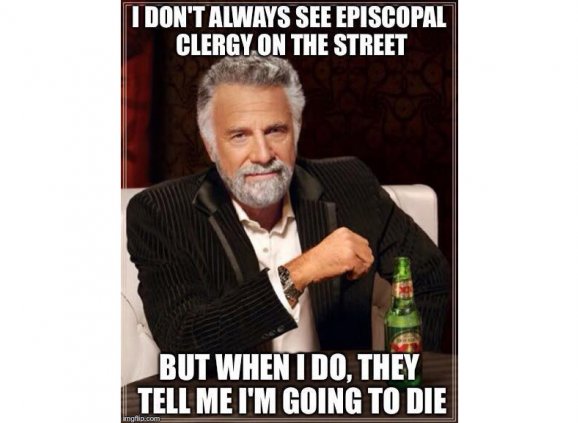
- Vested Interest
Ashes to Stay

There's a photo that goes around on social media at this time of year, from the fertile brain of organist David Sinden. Based on the popular Dos Equis commercial (and the series of spinoff memes it inspired), it shows a dapper older white gentleman with the words: "I don't always see Anglican clergy on the street...But when I do, they tell me that I'm going to die."
The last few years have seen a huge rise in the phenomenon of "Ashes to Go," an Ash Wednesday ministry in which clergy and lay leaders don vestments and take to the streets to offer ashes to all and sundry. Standing in parking lots and street corners wearing their clerical collars and vestments, they offer brief and compassionate encounters with those going by: the smear of the cross of ashes on their foreheads, the admonition to "Remember that you are dust, and to dust you shall return." “Ashes to Go” is a creative way of bringing liturgical ministries into the world. News media have covered it widely. People love it. I hate it.
I don’t hate Ashes to Go from a dislike of Ash Wednesday, but precisely because of my fierce love for it. During the times of intense depression and suicidal desires which have plagued me throughout my life, the Ash Wednesday liturgy has been a source of strange and unprecedented comfort. Briefly put, it's the only time when everyone around me is also thinking about mortality. It's the time when the church, as a body, risks openly naming a truth that is a source of sorrow and fear for nearly all of us: that we will all die, and so will everyone we love. Our bodies are made for change and decay, and our minds struggle to accept or even acknowledge this fact.
Most of us, I think, carry our griefs individually most of the time. 21st century America fears loss and despair, and does not permit its denizens to suffer in public. To be depressed or grieving in such a world thus means near-constant alienation, keeping one's largest truth unspoken. Living in this world, I greeted Ash Wednesday services as a miracle. Held in the time and space of the liturgy, for this one hour my sadness was not out of place. Surrounded by solemn faces, somber music, and the litany of repentance, I felt my closely held sorrow and shame be acknowledged and spoken aloud by all around me. Somehow I could be part of the world again.
Time and space were not optional elements in this transformation. I can’t stress this enough. To begin this journey together, I believe that we do have to be physically together, for longer than a brief touch and in more than a one-on-one encounter. When I receive the ashes on my forehead abruptly, on my way from one thing to another, that time and space is lacking, and one of two things happens: Either I dodge the issue and fail to engage with mortality; or it steals up on me as I walk away, and I am left struggling with it alone.
But people love it. It moves them so much. The fact that Ashes to Go is so popular is a clear sign that people are hungry for the church to be more present in their public-facing lives. But surely we can find a more fruitful public ministry? Just because people are hungry doesn’t mean that what we are giving them is the right food.
It is within the liturgy that we can carry our deaths together. Ash Wednesday offers each of us a chance to reckon with the darkness outside and the darkness within. As we make our ways along the journey of individual penitence and search to which Lent calls us, we know that none of us is alone in this. And this knowledge of mutual care is more than just a sop in despair. It is the very seed of awakening resurrection that flowers in Easter. We will die, and everyone we love will die. But in our love, and through God’s love, we—all of us—will also live.
At "Vested Interest," church nerd Mary Davenport Davis explores all things liturgy and music at Trinity and beyond. Chime in with comments and questions!


Comments